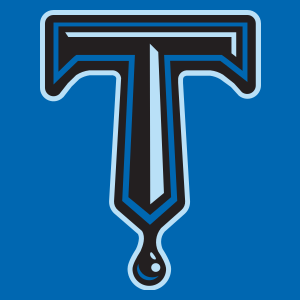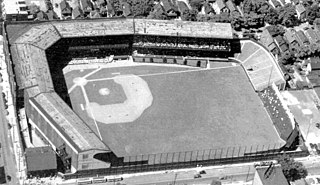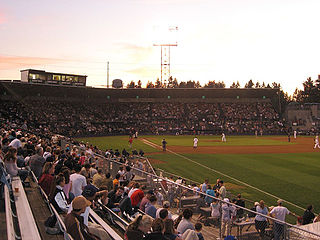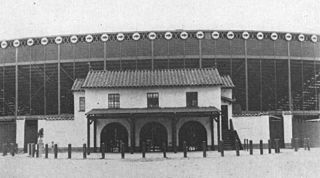
The Texas League is a Minor League Baseball league which has operated in the South Central United States since 1902. It is classified as a Double-A league. Despite the league's name, only its five South Division teams are actually based in the state of Texas; the five North Division teams are located in Arkansas, Kansas, Missouri, and Oklahoma. The league temporarily operated for the 2021 season as Double-A Central before reassuming its original moniker in 2022.

The New Orleans Pelicans or "Pels" were a minor league professional baseball team based in New Orleans, Louisiana.

The Midland RockHounds are a Minor League Baseball team based in Midland, Texas. The team, which plays in the Texas League, is the Double-A affiliate of the Athletics major league club. The RockHounds play in Momentum Bank Ballpark, which opened in 2002 and seats 4,709 fans. They have won seven Texas League championships: in 1975, 2005, 2009, 2014, 2015, 2016 and 2017.

The Tulsa Drillers are a minor league baseball team based in Tulsa, Oklahoma. The team, which plays in the Texas League, is the Double-A affiliate of the Los Angeles Dodgers major-league club.

League Park was a baseball park located in Cleveland, Ohio, United States. It was situated at the northeast corner of Dunham Street and Lexington Avenue in the Hough neighborhood. It was built in 1891 as a wood structure and rebuilt using concrete and steel in 1910. The park was home to a number of professional sports teams, most notably the Cleveland Indians of Major League Baseball. League Park was first home to the Cleveland Spiders of the National League from 1891 to 1899 and of the Cleveland Lake Shores of the Western League, the minor league predecessor to the Indians, in 1900. From 1914 to 1915, League Park also hosted the Cleveland Spiders of the minor league American Association. In the 1940s, the park was also the home field of the Cleveland Buckeyes of the Negro American League.

Cheney Stadium is a multi-purpose stadium located in Tacoma, Washington, United States. It is primarily used for baseball and is home to the Tacoma Rainiers of the minor league Pacific Coast League. The stadium also hosted professional soccer teams, including the Tacoma Defiance of the USL Championship until 2022 and OL Reign of the National Women's Soccer League until 2021. Cheney Stadium opened in 1960 and has a capacity of 6,500 seats. It is next to Henry Foss High School, and the stadium has an agreement with the school to use the school parking lot for parking.

Durham Athletic Park, nicknamed "The DAP", is a former minor league baseball stadium in Durham, North Carolina. The stadium was home to the Durham Bulls from 1926 through 1994, the North Carolina Central Eagles and the Durham School of the Arts Bulldogs. The DAP sits north of the downtown area of Durham, on the block bounded by Washington, Corporation, Foster and Geer Streets.
Drillers Stadium was a former minor league baseball stadium located in Tulsa, Oklahoma. From 1981 to 2009, Drillers Stadium was home to the Tulsa Drillers, of the Double-A Texas League. For a number of years Drillers Stadium also hosted one of the regular season baseball games played between Oklahoma State University and the University of Oklahoma in the Bedlam Series. Drillers Stadium is located on the southwest corner of Yale Avenue and 15th Street, in the Tulsa State Fairgrounds complex that also includes Expo Square Pavilion, the QuikTrip Center and Golden Driller, a racetrack, a waterpark, and the sites of the former Bell's Amusement Park and of Oiler Park, where Tulsa's professional baseball teams had played since 1934.

Avista Stadium is a baseball park in the northwest United States, located in Spokane Valley, Washington. It is the home ballpark of the Spokane Indians, a minor league baseball team in the High-A Northwest League.

Michael Robert Coolbaugh was an American baseball player and coach. Born in Binghamton, New York, he was the brother of major leaguer Scott Coolbaugh. Coolbaugh died after being hit by a line drive while working as a first-base coach in a minor league game.

The Tulsa Oilers, located in Tulsa, Oklahoma, were a minor league baseball team that existed on-and-off in multiple leagues from 1905 to 1976. For most of their history, they played at Oiler Park, which opened on July 11, 1934, and was located on the Tulsa County Fairgrounds at 15th Street and Sandusky Avenue.

Buffalo Stadium was a minor league stadium primarily used by the Houston Buffaloes from 1928 through 1961. It was the site of the first night game between two major league baseball clubs, which took place between the Chicago White Sox and New York Giants in 1931. The Buffaloes were a farm team of the Major League St. Louis Cardinals and provided many great ballplayers to the Cardinals' success in 1930s and 1940s. The arrival of the National League Houston Colt .45s in 1962 brought an end to minor league baseball in Houston. It also went by the names of Buff Stadium and later Busch Stadium. It was bounded by Leeland Street, St. Bernard Street, Coyle Street, and Milby Street in the East End. The railroad tracks leading to Union Station, site of the Houston Astros' current ballpark, ran behind the center field wall. Near the University of Houston, the stadium was also home to the Houston Cougars baseball team during the 1940s.

Oneok Field is a baseball park in Tulsa, Oklahoma. Located in the historic Greenwood district adjacent to downtown Tulsa, it is the home of the Tulsa Drillers of the Texas League. The stadium is named for Oneok.

West End Park was a baseball park in Houston from 1905 to the 1940s. It was the primary ballpark for the city when it was constructed, and the city's first venue for Negro Major League games. From 1909 through 1910 and again in 1915, it also served as the spring training facility of the St. Louis Browns as well as the 1914 New York Yankees of the American League and the 1906 through 1908 St. Louis Cardinals of the National League in Major League Baseball. After its use by its primary tenant, the Houston Buffaloes of the Texas League, the ballpark was sold to what is now known as the Houston Independent School District for its use until it was demolished.
A. Ray Smith was a long-time baseball executive, best known for his ownership of the minor-league Tulsa Oilers franchise, which he later moved to Louisville, Kentucky, where the team set minor league attendance records.
The Lafayette Drillers baseball club was an American minor league baseball franchise representing Lafayette, Louisiana, that played for two seasons, 1975–76, in the Double-A Texas League as an affiliate of the San Francisco Giants. The team played its home games at Clark Field.

Riverfront Stadium is a baseball park in downtown Wichita, Kansas, United States. It serves as the home ballpark of the Wichita Wind Surge of the Texas League. The team relocated from the New Orleans suburb of Metairie, Louisiana, after the 2019 season.
Minor league baseball teams were based in Baton Rouge, Louisiana in various seasons between 1902 and 2003. The Baton Rouge minor league teams played as members of the Cotton States League, Dixie League (1933), East Dixie League (1934), Evangeline League (1946–1957), Gulf States League (1976), All-American Association (2001) and Southeastern League (2002–2003).
Minor league baseball teams were based in Lafayette, Louisiana between 1907 and 2000. Lafayette teams played as members of the 1907 Gulf Coast League 1920 Louisiana State League and Evangeline League. Lafayette teams won four league championships and one pennant in the era. The early Lafayette teams preceded the 1975 and 1976 Lafayette Drillers, who played as members of the Texas League and the 1998 to 2000 Bayou Bullfrogs of the Texas-Louisiana League.










